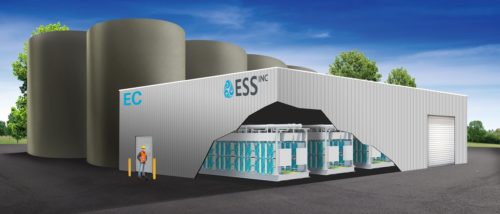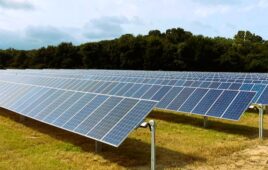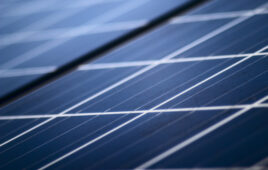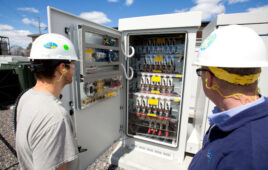Long-duration iron-based flow battery manufacturer ESS has launched its new “Energy Center” system. The utility-scale energy storage system is flexible and sized to specific front-of-meter needs for larger commercial and industrial facilities.
 In contrast to the company’s field-proven Energy Warehouse, a standalone 75-kW/500-kWh containerized system, the Energy Center can be tailored and scaled to accommodate specific projects and enable the stacking of a range of storage applications. The systems can be configured in different power capacities, starting at 3 MW, with energy durations ranging from 6 to 16 hours, to support large-scale renewable energy projects, provide transmission- and distribution-level services, and for utility peaker plant replacement applications. Underscoring their sustainable value and low operating cost, Energy Centers have a projected operating life of approximately 25 years without performance degradation.
In contrast to the company’s field-proven Energy Warehouse, a standalone 75-kW/500-kWh containerized system, the Energy Center can be tailored and scaled to accommodate specific projects and enable the stacking of a range of storage applications. The systems can be configured in different power capacities, starting at 3 MW, with energy durations ranging from 6 to 16 hours, to support large-scale renewable energy projects, provide transmission- and distribution-level services, and for utility peaker plant replacement applications. Underscoring their sustainable value and low operating cost, Energy Centers have a projected operating life of approximately 25 years without performance degradation.
“As we are seeing market requirements for utility-scale energy storage moving from traditional 2- to 4-hour lithium-ion-based capability to longer 8- to 12-hour durations that emphasize flexibility and long life, it is clear that proven and practical flow batteries offer key design and cost advantages over lithium,” stated Mark Burton, Senior Engineer for Energy Storage at Enertis Solar. “We have been working closely with ESS on optimizing the overall design of the Energy Center solution to meet the unique site design and balance of plant requirements for these large, long-duration battery systems.”
The Energy Center utilizes an environmentally benign and sustainable flow battery chemistry composed of earth-abundant iron, salt, and water, and containing no hazardous chemicals or rare-earth metals. The iron flow battery presents no fire, chemical, or explosive risk, eliminating the need for fire suppression, secondary containment, and hazmat precautions, resulting in the greenest, most sustainable, and easiest-to-permit storage technology available.
David Brown, Senior Principal and Co-founder of Obsidian Renewables, one of the largest developers of solar power facilities in the Pacific Northwest, commented, “A rapid and dramatic shift is occurring that favors pairing larger-scale battery installations with renewables. These projects are finding improved overall customer value from longer duration, daily cycling and the flexibility to adapt to evolving use cases that are not constrained by cycle life. We are excited about the economics, operating life and design flexibility that the ESS Energy Center solution offers.”
In an independent assessment conducted at the University of California-Irvine, scientists evaluated the environmental impact of three different flow battery chemistries, to which was added supplementary information analyzing four different lithium-ion designs. Researchers assessed production processes and end-of-life stages and compared results, measuring global warming potential, ozone depletion potential, acidification potential, freshwater usage and other environmental criteria. Flow batteries were found to be significantly less harmful to the environment than lithium-ion batteries, thanks to earth-abundant materials, far longer operating life, and ease of end-of-life material recycling.
“We are very pleased to introduce and deliver the only truly environmentally safe, highly flexible and customizable, long-duration storage solution to the market,” said Craig Evans, ESS President and CEO. “The availability of a low-cost, ultra-long-life energy storage solution with the lowest environmental impact will help reduce customer costs and meet the most stringent sustainability objectives. Based on the rapid and continued growth of renewable resources that are driving energy markets, long-duration storage solutions like ours will help catalyze the energy transition and tackle climate change head on.”
According to the industry’s top research firms, the market for long-duration storage on a global basis is projected to grow exponentially in the coming decades. In California alone, the state will need to deploy between 45 and 55 GW of long-duration energy storage to meet its goal of eliminating greenhouse gas emissions (GHG) from electricity by 2045.
News item from ESS




Hi Kelly,
You have a factual error in your article. You write “Among flow batteries, ESS’s all-iron technology presented the lowest overall environmental impact compared to batteries using vanadium and zinc” and cite the report conducted by University of California-Irvine (Flow battery production: Materials selection and environmental impact). However, if you read the report’s conclusion, that is not what it says. They are explicit that in the case of vanadium batteries, the source of the vanadium plays a huge role. Depending on what source is used (e.g. steel by-product vs spent catalyst), “vanadium redox flow batteries exhibit the lowest” impacts. The report does not even touch on primary production of vanadium as a source.
It would be great if you could correct that part of the article.
Thank you.
“The systems can be configured in different power capacities, starting at 3 MW, with energy durations ranging from 6 to 16 hours, to support large-scale renewable energy projects, provide transmission- and distribution-level services, and for utility peaker plant replacement applications.”
With the technology available today and the cost of solar PV has still dropped despite tariff ‘protections’, the format of construction for solar PV farms has changed over just the last 10 years. Now string inverters with higher D.C. buss voltages are available, utility scale solar PV panels that are large foot print from 24 to 28 square feet and specifically designed for 200 VDC plus from each panel makes string voltages higher to feed the new inverters. The ‘old’ concept of oversizing the D.C. buss compared to the A.C. output of 1.5 to 1 can have this type of energy storage installed to extend the energy use from the solar PV generation day. A relatively new technology is the D.C./D.C. serial solar PV farm. The strings are sent to D.C. converters that feed directly into the energy storage D.C. input, the buss derived goes to inverter(s) to generate electricity day or night. This type of system could also be set up to be a flexible dispatch resource. Depending on energy storage capacity, if a system like this could have flexible outputs then a system for a commercial or industrial entity could have 100MWh for four hours, or 50 MWh for 8 hours or 25MWh for 16 hours. This type of set up could also allow, generate and store solar PV during the day and dispatch at night. Adios, Peaker plants.